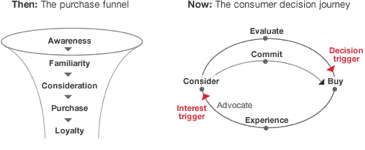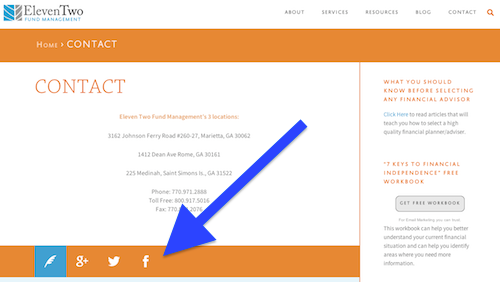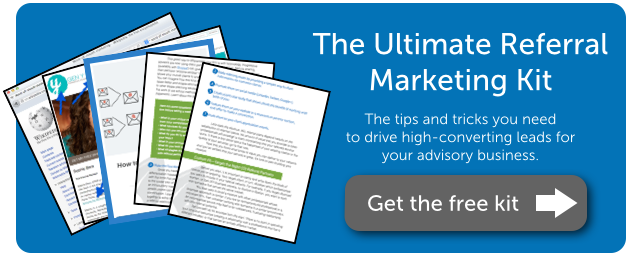Last Updated on July 20, 2020 by Carolyn McRae
This post in the first in a series to help you better understand how digital marketing is creating new opportunities to drive growth through referrals.Traditional referrals are under threat.
… and we all feel it.
 Financial advisor thought-leader Michael Kitches argues that digital search may end tradition referrals as a major lead source.
Financial advisor thought-leader Michael Kitches argues that digital search may end tradition referrals as a major lead source.
Supporting this, a study by Cerulli Associates found that a referral was the deciding factor in selecting an advisor only 11% of the time.
It’s true that a referral (in most cases) is only the first step, and we all know a “hope” strategy based on the expectation that your good work will drive referrals is not likely to work.
However, there is still a glimmer of hope. A study by Advisor Impact found 83% of clients are willing to refer and 29% actually do, and referrals have very high conversion rates – 50% to 70%, on average.
Referrals clearly are still a big opportunity. But for your referral program to work, you need to defeat two (very crucial) challenges.
The first challenge is to educate your client base so that they know exactly what you are great at and energize them so that they feel compelled to make the recommendation because they want to spread the good word.
The next challenge is to provide the right support to make sure that that the referral actually makes contact. A differentiated positioning combined with technologies like web, email and social can help you achieve both these goals.
Here’s how we can do it…
From Funnel to Journey
The biggest thing most advisors don’t realize is that the old idea of a linear referral funnel no longer works. Today, the path is not linear. In fact, it is likely to take multiple contacts before the referred prospect is ready to contact your firm directly.
As we all know, common contact points include:
● Your website to understand why your firm is different and whether the brand lines up with the referrer’s preferences.
● Social profiles to get a sense of your firm’s focus and culture.
● Email newsletters to get a sense for what it is like to be a client before actually becoming one.
But here’s where most advisors miss the mark in their understanding of what a referrer experiences: There is not one experience or conversion funnel they all follow, but rather a series of influencing points that lead to channels where the prospect is most comfortable making contact.
Consulting firm McKinsey pioneered this thinking about the customer decision journey.

McKinsey goes on to recommend that we do four things given this new decision journey.
1. Align – Marketing resources should align with where clients spend their time. Web, email and social channels become more important. Traditional referral partners (like accountants and lawyers) also remain relevant.
2. Link – Multi-touch points mean that your firm needs to present a consistent, easily-understandable message across all channels. The message that the referring client communicates to the referred prospect needs to be reinforced on the website, social and printed materials. Otherwise, the referred prospect easily gets lost and struggles to remember why they originally sought out your firm in the first place.
3. Lock – McKinsey emphasize marketing channels where you can “lock in” a customer’s attention. The most important of these are direct, opt-in channels like email subscriptions and social media. These channels are opt-in, so people feel empowered and are more welcoming of your information when it passes by them.
4. Loop – Creating an effective loyalty loop means that you look at all client touch points and find ways to engage using content.The goal is to energize the client base to move them from passive loyalists to active loyalists that refer.
Stages in Your Referred Prospect’s Journey
Let’s look at the top digital channels and how they align with this new journey.
1. Align and Link
This stage relies heavily on strong branding and differentiated positioning. Research shows that search, web and social line up as the most effective and trusted channels for the initial contacts. More on that in the next post. Making sure that your messaging across all channels is consistent and engaging is the objective at this stage. Remember, in-person channels are also effective. Your partners, clients and staff need to be on the same page and be communicating a differentiated message that is consistent with your other channels.
– Top areas of focus here:
a. Messaging – You should have a very clear message about why your firm is different and why the referred client should care. This core message needs to be reinforced across all channels.
Michael Kitces offers some great thinking around advisors needing to own a “best at” niche in Want More Referrals? Be More Referrable!
b. Cover the key channels – Mobile is about to become the main way that people interact with the internet. Not having a mobile friendly website and sending emails that are not mobile optimized are referral killers. Basic channels like LinkedIn, Facebook, Youtube and Twitter need a presence.
2. Lock
Email and social engagement are the winners here. An opt-in email list is a powerful marketing asset for any advisory firm. Don’t get hung on numbers with this. Genuine opt-ins need to be nurtured even if the list is small. Same with social followers or likes. The majority of social followers will not be real prospects, but the few that are make it worth your effort. Some advisors worry about creating too much noise. Remember a typical open rate on an email is less 10%. Recipients have a choice about whether to open the email. Only 2% of your page likes are going to see a Facebook post. An active content program on social aligned with your core themes and messaging is important to move the referred prospect through their decision journey. Be patient. It can take 5-7 meaningful touch points to win a new client.
– Top areas of focus here:
a. Invest in content – Great content is vital. Prioritize quality over quantity and make sure that you continually promote it.
b. Give the referral plenty of options to make contact – Include a call-to-action (CTA) button on every page and include in email and social channels. You want to make it easy for the referred prospect to make the next step. Typically include the button above the fold or in the area that you see without having to scroll if you are on a laptop as well as a button at the bottom of a page for people that do scroll. The offer can be as simple as signing up for your newsletter or a free consultation. Whatever the offer, the goal is to get the referred prospect to opt-in so you can engaged directly. Check out this article by KissMetrics if you want to understand effective call-to-action strategies.
3. Loyalty Loop
Your referral is now a client. Time to energize them to drive new referrals. Ideally, one person should be tasked with finding ways to engage with existing clients through content in a measurable way. Data tracking will help you measure what is working and what is not. For example, regular email opens and click-throughs by one individual suggests their interest. The work that you do with new content on your social channels, blog and video will not only reinforce your core message to prospects, it will also continue to energize your client base driving more referrals. Metrics like shares and views are relevant with these channels. Client service and reporting processes provide opportunities in areas not traditionally seen as marketing.
– Top area of focus here:
a. Client touch point review – Take a look at all the ways that you interact with your clients and review for consistency with your core message as well as identify need opportunities to engagement your client base using your content program. Do the same for your partners. Make sure that you are giving your clients and partners the right tools whether it is videos or blog posts to help make them feel compelled to share. Make it easy for them to opt-in to all your channels from email through to social. Take every opportunity to encourage them to be part of your “tribe”.
Real World Example
I’d like to suggest ElevenTwo Financial Management as a good example of an advisor site that aligns well with customer journey strategies.
Value proposition: ElevenTwo overall claim of Client Focused and Results Driven is not unique. However, they use numbers (94%) to demonstrate that they are different for other advisors. The use of an authentic image of the founder personalize the offer. The willingness to pay the prospective client if their experience is not first rate make ElevenTwo’s service claims more credible.
Call-to-action: The “Learn More” is a low risk next step for the visitor. The purpose of any web page is to get the next step.
Content: ElevenTwo offer relevant content to referrals with an article on “What you should know before selecting any financial advisor” promoted on the home page. They also offer a short shareable video asked the question whether you have a dietician or butcher as your financial advisor.
Social opt-in: ElevenTwo’s social accounts are highlighted at the bottom of every page, including their Contact page as shown below:

It’s Your Turn
The most effective sales channels are high trust channels. That is why referrals are such a powerful way to grow your firm. The first challenge is energizing your client base and partners with a clear, differentiated message and is consistently reinforced. This primes the referral system. The next step is managing the decision journey of the referrals so your “best at” message is consistently reinforced in engaging ways across the various touch points. The opportunity for those advisors who get the digital referral system right is significant especially as the focus turns to attracting Generation X and then Millennial clients.
In the next post of this series, we’ll find out which channels influence the client decision journey the most based on the latest research.
